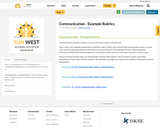
These are example rubrics for measuring growth in COMMUNICATION. Rubrics are provided for K-5, 6-9 and 10-12.
- Subject:
- Education
- Material Type:
- Assessment
- Date Added:
- 02/24/2020

These are example rubrics for measuring growth in COMMUNICATION. Rubrics are provided for K-5, 6-9 and 10-12.

Sun West Communication High School Grade 10-12 Guidebook- please use the table of contents to navigate the guidebook. Also, we invite you to share resources you think would be suitable for this guidebook with any of the author's of this guidebook.
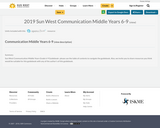
Sun West Communication Middle Years Grade 6-9 Guidebook- please use the table of contents to navigate the guidebook. Also, we invite you to share resources you think would be suitable for this guidebook with any of the author's of this guidebook.
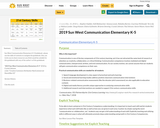
Sun West Communication Elementary K-5 Guidebook- please use the table of contents to navigate the guidebook. Also, we invite you to share resources you think would be suitable for this guidebook with any of the author's of this guidebook.
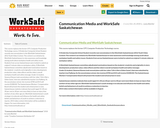
This course replaces the former CPT; Computer Production Technology course.
A Kindersley Composite School Student recently won second place in the WorkSafe Saskatchewan 2012 Youth Video Contest. The contest is an initiative by WorkSafe Saskatchewan to raise awareness and knowledge among youth about workplace health and safety issues. Students from across Saskatchewan were invited to submit an original 3-minute video on workplace safety.
A WorkSafe Saskatchewan committee adjudicated nominations based on the students’ creativity and originality in story development, production value, video effects and the video’s overall workplace health and safety message.
Grade 12 student, Vanessa Klassen took second place with her video “Life is Not a Video Game”, that was submitted by teacher Lisa Padberg. As the second place winner she receives $700 and KCS will receive $1000.00. The Saskatchewan Workers’ Compensation Board will present the student and school prizes in June.
Saskatchewan statistics indicate that youth (aged 15-24) are 20 per cent to 30 per cent more likely to have an injury than workers of any other age are. WorkSafe Saskatchewan’s youth strategy is to educate and influence the health and safety beliefs and behaviours of youth to achieve a reduction in injuries.
2013 video contest information will be available in August.
For more information, visit: http://www.worksafesask.ca/

Communication Systems Projects with LabVIEW features ten project activities in digital communication systems based on the LabVIEW graphical dataflow programming platform. Each project includes introductory material in the form of text and narrated screencast videos, specifications for low-level subVI building blocks, and step-by-step instructions to assemble application VIs to implement a variety of simulations, visualizations, and working transmitters and receivers. This textbook organizes the projects into related topics, including: (1) Simulation and Visualization of Fundamental Concepts, (2) Channel Coding and Error Control, (3) FSK Demodulation (Caller ID), and (4) Bandpass Communications over the Speaker-Air-Microphone Channel.

In which John Green teaches you about China's Revolutions. While the rest of the world was off having a couple of World Wars, China was busily uprooting the dynastic system that had ruled there for millennia. Most revolutions have some degree of tumult associated with them, but China's 20th century revolutions were REALLY disruptive. In 1911 and 1912, Chinese nationalists brought 3000 years of dynastic rule to an end. China plunged into chaos as warlords staked out regions of the country for themselves. The nationalists and communists joined forces briefly to bring the nation back together under the Chinese Republic, and then they quickly split and started fighting the Chinese Civil War. The fight between nationalists and communists went on for decades, and was interrupted by an alliance to fight the invading Japanese during World War II. After the World War II ended, the Chinese Civil War was back on. Mao and the communists were ultimately victorious, and Chiang Kai-Shek ended up in Taiwan. And then it got weird. Mao spent years repeatedly trying to purify the Communist Party and build up the new People's Republic of China with Rectifications, Anti Campaigns, Five Year Plans. the Great Leap Forward, and the Cultural Revolution. These had mixed results, to say the least. John will cover all this and more in this week's Crash Course World History.
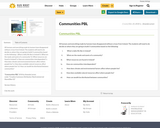
All humans and everything made by humans have disappeared without a trace from Ireland. The students will need to do decide on where they are going to build 3 communities based on the following:
i. What is daily life like in Ireland?
ii. What are the needs and wants of a community?
iii. What resources are found in Ireland?
iv. How are communities interdependent?
v. How does climate and environmental factors affect where people live?
vi. How does available natural resources affect where people live?
vii. How can wealth be distributed between communities?
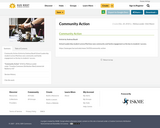
Community Action
Article by Andrew Bauld
School Leadership student Lorena Martinez sees community and family engagement as the key to students' success.

Students will discuss different kinds of communities and create brochures to demonstrate their learning.

Interactions between species are what define ecological communities, and community ecology studies these interactions anywhere they take place. Although interspecies interactions are mostly competitive, competition is pretty dangerous, so a lot of interactions are actually about side-stepping direct competition and instead finding ways to divvy up resources to let species get along. Feel the love?

Hank gets to the more violent part of community ecology by describing predation and the many ways prey organisms have developed to avoid it.

By the end of this course the students should be able to: Identify the root of Community Health Nursing; identify supportive organizations; differentiate between Public Health Nurse and Community Health Nurse; explain Community Health Nursing; describe the qualities of the Community Health Nurse; describe the different types of community; differentiate between urban and rural communities and outline community profile; explain community entry; describe the preparations made before a community is entered; identify critical actions in community entry; list the advantages of community entry; explain community study; list at least four reasons for community study; explain the various types community study; give two explanation to each data collected; define a community need; identify types of needs; identify the process community needs assessment and list the uses of needs assessment.

An inquiry-based project to map the land in your community. The key concepts in this unit are grounded in Indigenous beliefs of interconnectedness, connectedness, and respect for all things.
The driving inquiry questions for this unit are:
1. How can respect for the land be shown?
2. What do we look for when setting up a camp?
3. What stories or teachings are connected to key locations in and around our community?
4. How has the land around our community changed over time?
5. Who do we share our community’s lands with?
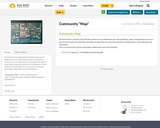
My Action Plan is related to Social Studies and the use of collaboration and critical thinking. I plan to evaluate the resources I am currently using in Social Studies and adjust or adapt them to move in the direction of collaboration, critical thinking, and technology.
This is an activity that involves technology, collaboration and critical thinking.
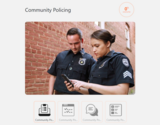
This lesson for English Language Learners (ELLs) discusses a movement that brings police officers closer to the people they serve, community policing. In this lesson, learners will practice reading, listening, speaking and writing. All activities are automatically graded with feedback provided to the learner upon submission.

iNaturalist is an identification key for plants, protist, fungi and animal species. It has online features as well as an app for Apple or Android, and is a joint initiative between California Academy of Sciences and the National Geographic Society.

The ComPADRE Digital Library is a network of free online resource collections supporting faculty, students, and teachers in Physics and Astronomy Education. Each collection contains materials designed for a specific community.
Select teaching resources to start exploring. Also select resources from the top menu to find more options - including for students.

Hank introduces us to comparative anatomy, which studies the similarities and differences in animal anatomy to support the theory of evolution and the shared ancestry of living things.

This short video and interactive assessment activity is designed to teach second graders about making observations about capacity (metric units).